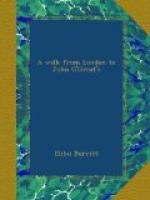Put, then, the man who plants trees for posterity with him who, “passing through the valley of Baca, maketh it a well.” Put him under the same blessing of his kind, for he deserves it. He gives them the richest earthly gift that a man can give to a coming generation. In a practical sense, he gives them time. He gives them a whole century, as an extra. If they would pay a gold sovereign for every solid inch of oak, they could not hire one built to the stature of one of these trees in less than two centuries’ time, though they dug about it and nursed it as the man did the vine in Scripture. Blessed be the builders of these living temples of Nature! Blessed be the man, rich or poor, old or young, especially the old, who sets his heart and hand to this cheap but sublime and priceless architecture.
Let connoisseurs who have seen Memphis, Nineveh, Athens, Rome, or any or all of the great cities of the East, ancient or modern, come and sit here, and look at this lofty corridor, and mark the orders and graces of its architecture. What did the Ptolemies, their predecessors or successors in Egypt, or sovereigns of Chaldaic names, in Assyria, or ambitious builders in the ages of Pericles or Augustus, in Greece or Rome? Their structures were the wonders of the world. Mighty men they were, whose will was law, whose subjects worked it out to its wildest impulse without a murmur or a reward. But who built this sixty-columned temple, and bent these lofty arches? Two or three centuries ago, two men in coarse garb, and, it may be, in wooden shoes, came here with a donkey, bearing on its back a bundle of little elms, each of a finger’s girth. They came with the rude pick and spade of that time; and, in the first six working hours of the day, they dug thirty holes on this side of the aisle, and planted in them half the tiny trees of their bundle. They then sat down at noon to their bread and cheese and, most likely, a mug of ale, and talked of small, home matters, just as if they were dibbling in a small patch of wheat or potatoes. They then went to work again and planted the other row; and, as the sun was going down, they straightened their backs, and, with hands stayed upon their hips, looked up and down the two lines and thought they would pass muster and please the master. Then they shouldered their brightened tools and went home to their low, dark cottages, discussing the prices of bread, beer and bacon, and whether the likes of them could manage to keep a pig and make a little meat in the year for themselves.
That is the story of this most magnificent structure to which you look up with such admiration. Those two men in smock frocks, each with a pocket full of bread and cheese, were the Michael Angelos of this lofty St. Peter’s. That donkey, with its worn panniers, was the only witness and helper of their work. And it was the work of a day! They may have been paid two English shillings for




